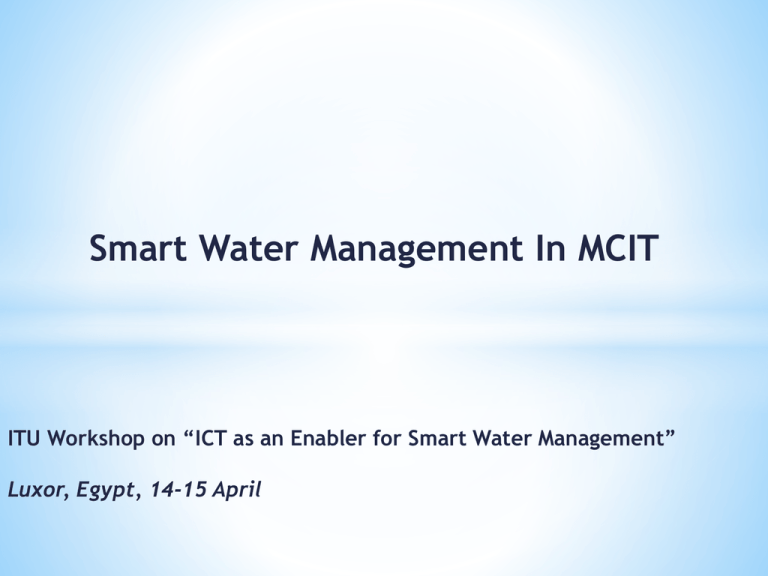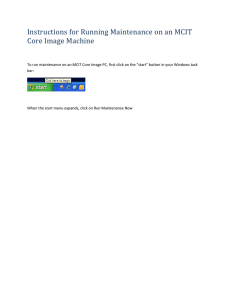Smart Water Management In MCIT Luxor, Egypt, 14-15 April
advertisement

Smart Water Management In MCIT ITU Workshop on “ICT as an Enabler for Smart Water Management” Luxor, Egypt, 14-15 April Content 1. Introduction 2. Facts 3. Water use in MCIT 4. Ways of water management in MCIT 1. 2. Implemented projects New projects 1.Introduction • Demands are increasing every year for water while resources are becoming more and more limited. • Since many individuals are unaware (or , sadly , just don’t care) that this issue needs attention, it is up to more informed and proactive individuals and companies to take up the slack. 1.Introduction • • A percentage of 40% increase is expected in water demand over the period of next two decades. The increase in water demand is a contribution of various factors including growing population, increased agricultural needs, industrial use of water and water needed for electricity production. 1.Introduction • The problem of water waste is severe in countries where people are using the same inefficient methods for irrigation of agricultural land. • Water needs are increasing every year and the proven fact is that clean water is not available to 1 out of 5 people on the earth. 2.Facts With all the oceans, rivers, lakes, and reservoirs on the planet only one percent of that water is fit to drink An average home is wasting approximately 10,000 gallons ( 38 m3 ) of water per year running it down to the drain waiting for hot water 12 African countries considered to be in a “Water Stress” situation. Every day, 2 million tons of sewage , industrial and agricultural waste are discharged into the world’s water, the equivalent of the weight of the entire human population of 6.8 billion people 2.Facts 4% of the population receive water > 8 Hrs/day 33% receive water > 4 Hrs/day 42% receive water for just 3 Hrs/day 21% receive water < 3 Hrs/day(often only 1 hr) 2.Facts Toilets used the most water on a daily basis (20.1 gallons per person per day) The hydrological cycle WATER SCARCITY IN EGYPT • Egypt occupies slightly more than one million km2 • • only 6 % of total land area is suitable for settlement. • About 60 thousand km2 of the land that covers the Nile Delta and Nile Valley is populated for 67 million people • The annual population growth rate is 2.1 % • More than 96 % of Egypt’ fresh water resources is supplied by the river Nile (UNCCA- United Nation Common Country Assessment ) What are we dreaming for ? - Increasing water recourses - Increment awareness towards majority importance off water scarcity problem - Proper handling of water for irrigation and different usages - Decreasing water consumption 4.Water use in MCIT Bathrooms kitchens Fountains landscaping Heating & cooling 5. Smart Ways to Manage Water In MCIT Raise awareness Repair leaks Replace equipment Record, analyze and compare monthly consumption landscaping that overuse Implementing new projects Raise awareness Water management Meetings with staff to raise awareness AT WORK Raise awareness AT HOME gallons 20 to 40 Raise awareness Changing employees behavior explaining method of water saving at home, street, work, making water saving as an culture of each one. sending reminder emails to employees every month to Instructs hem reduce water consumption. Don’t flush your miscellaneous waste in the toilet. Rewards For new ideas related to water or energy saving. Developing social responsibility For every one working for MCIT . Repair leaks Replace & install new equipment 360 m3 / day ) landscaping that overuse • • • • Using irrigation (raw water) for cooling towers to safe about 360 m3/day potable water. • Cooling towers chemical Management to minimize bleeding to 40% . • Selecting plants and trees need low water ( Yucca , Jatrova , Opountia , Agave , … ) Programmed irrigation system Irrigation sprinkler صورة كنترول رى المعادى مع نظام الرى Irrigation control valves Lagoon water is reused for irrigation inside smart village instead of drain it to save about 40,000 m3 Amount of water after & before installing the water saver New Projects 250 m3/day. 112 m3/day. 360 m3 / day New Projects Modifying the softeners for chillers planet by recycling the softener and filter drainage to safe about 112 m3/day. Using variable speed drive pumps & pressure sensors to control and minimize irrigation water References * * * * http://www.benefits-of-recycling.com/importanceofconservationofwater/ * Abu-Zeid, M. Water resources assessment for Egypt. Ministry of Water Resources and Irrigation. Egypt * World Water Demand and Supply,1990 to 2025: Scenarios and Issues (David Seckler, Upali Amarasinghe, David Molden, Radhika de Silva, and, Randolph Barker) http://www.benefits-of-recycling.com/importanceofconservationofwater/ http://www.benefits-of-recycling.com/waterconservationdevices/ http://www.epa.gov/watersense/ http://www.epa.gov/nps/chap3.html http://www.epa.gov/ow/citizen/thingstodo.html http://planetgreen.discovery.com/go-green/green-water/green-waterstatistics.html Thank you





